.
28.01.2014
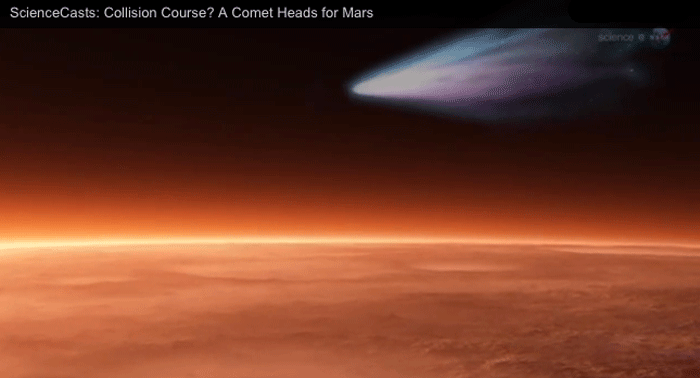
.19.Oktober 2014 -Mars-Szenario mit Komet Siding Spring
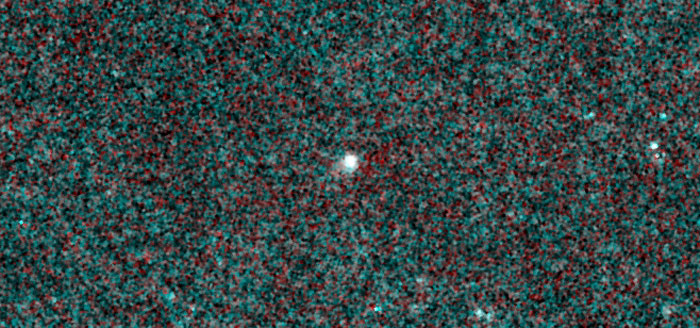
NASA's NEOWISE mission captured images of comet 2013 A1 Siding Spring, which is slated to make a close pass by Mars on Oct. 19, 2014.
.
NEOWISE Spies Comet C/2013 A1 Siding Spring
NASA's NEOWISE mission captured images of comet C/2013 A1 Siding Spring, which is slated to make a close pass by Mars on Oct. 19, 2014. The infrared pictures reveal a comet that is active and very dusty even though it was about 355 million miles (571 million kilometers) away from the sun on Jan. 16, 2014, when this picture was taken.
The infrared measurements will allow astronomers to determine the sizes and quantity of dust particles being flung off the comet. The measurements will also give engineers some indications of what orbiting spacecraft at Mars might expect when the comet gets close. Preliminary analysis of the data indicate approximately 220 pounds (100 kilograms) of dust are being ejected from the comet's surface each second, assuming the grains are dark and nearly the density of water-ice. The comet's activity is expected to increase as it gets closer to Mars.
Image credit: NASA/JPL-Caltech
.
NASA Preparing for 2014 Comet Watch at Mars
.
This spring, NASA will be paying cautious attention to a comet that could put on a barnstorming show at Mars on Oct. 19, 2014.
On that date, comet C/2013 A1 Siding Spring will buzz Mars about 10 times closer than any identified comet has ever flown past Earth.
Spacecraft at Mars might get a good look at the nucleus of comet Siding Spring as it heads toward the closest approach, roughly 86,000 miles (138,000 kilometers) from the planet, give or take a few percent. On the other hand, dust particles that the comet nucleus sheds this spring could threaten orbiting spacecraft at Mars in October.
The level of risk won’t be known for months, but NASA is already evaluating possible precautionary measures as it prepares for studying the comet.
"Our plans for using spacecraft at Mars to observe comet Siding Spring will be coordinated with plans for how the orbiters will duck and cover, if we need to do that," said Rich Zurek, Mars Exploration Program chief scientist at NASA's Jet Propulsion Laboratory, Pasadena, Calif.
Comet Siding Spring, formally named C/2013 A1, was discovered on Jan. 3, 2013, from Australia's Siding Spring Observatory. At the time, it was farther from the sun than Jupiter is. Subsequent observations enabled scientists at JPL and elsewhere to calculate the trajectory the comet will follow as it swings past Mars. Observations in 2014 will continue to refine knowledge of the comet's path, but in approximate terms, Siding Spring's nucleus will come about as close to Mars as one-third of the distance between Earth and the moon.
Comet Ready for Its Close-up
Observations of comet Siding Spring are planned using resources on Earth, orbiting Earth, on Mars and orbiting Mars, and some are already underway. NASA's Hubble Space Telescope and the NEOWISE mission have observed the comet this month both to characterize this first-time visitor from the Oort cloud and to study dust particle sizes and amounts produced by the comet for understanding potential risks to the Mars orbiters. Infrared imaging by NEOWISE reveals a comet that is active and dusty, even though still nearly three-fourths as far from the sun as Jupiter is. Ground-based observatories such as the NASA Infrared Telescope Facility are also expected to join in as the comet becomes favorably positioned for viewing.
As the comet nears Mars, NASA assets there will be used to study this visitor from distant reaches of the solar system.
"We could learn about the nucleus -- its shape, its rotation, whether some areas on its surface are darker than others," Zurek said.
Researchers using spacecraft at Mars gained experience at trying to observe a different comet in 2013, as comet ISON (formally C/2012 S1) approached Mars. That comet's Mars-flyby distance was about 80 times farther than Siding Spring's will be. Another difference is that ISON continued inward past Mars for nearly two months, briefly becoming visible to some unaided-eye skywatchers on Earth before flying very close to the sun and disintegrating. Siding Spring will reach its closest approach to the sun just six days after its Mars flyby. It won't put on a show for Earth, and it won't return to the inner solar system for about a million years.
At comet Siding Spring's flyby distance, the High Resolution Imaging Science Experiment (HiRISE) camera on NASA's Mars Reconnaissance Orbiter could provide imagery with resolution of dozens of pixels across the diameter of the nucleus. When HiRISE observed comet ISON, the nucleus was less than one pixel across. ISON did not get bright enough to make itself visible to other cameras at Mars that made attempted observations, but Siding Spring could provide a better observation opportunity.
Cameras on the Mars rovers Curiosity and Opportunity might watch for meteors in the sky that would be an indication of the abundance of particles in the comet's tail, though the geometry of the flyby would put most of the meteors in daytime sky instead of dark sky.
"A third aspect for investigation could be what effect the infalling particles have on the upper atmosphere of Mars," Zurek said. "They might heat it and expand it, not unlike the effect of a global dust storm." Infrared-sensing instruments on Mars Reconnaissance Orbiter and Odyssey might be used to watch for that effect.
Assessing Possible Hazards to Mars Orbiters
One trait Siding Spring shares with ISON is unpredictability about how much it will brighten in the months before passing Mars. The degree to which Siding Spring brightens this spring will be an indicator of how much hazard it will present to spacecraft at Mars.
"It's way too early for us to know how much of a threat Siding Spring will be to our orbiters," JPL's Soren Madsen, Mars Exploration Program chief engineer, said last week. "It could go either way. It could be a huge deal or it could be nothing -- or anything in between."
The path the nucleus will take is now known fairly well. The important unknowns are how much dust will come off the nucleus, when it will come off, and the geometry of the resulting coma and tail of the comet.
During April and May, the comet will cross the range of distances from the sun at which water ice on a comet's surface typically becomes active -- vaporizing and letting dust particles loose. Dust ejected then could get far enough from the nucleus by October to swarm around Mars.
"How active will Siding Spring be in April and May? We'll be watching that," Madsen said. "But if the red alarm starts sounding in May, it would be too late to start planning how to respond. That's why we're doing what we're doing right now."
Two key strategies to lessen risk are to get orbiters behind Mars during the minutes of highest risk and to orient orbiters so that the most vulnerable parts are not in the line of fire.
The Martian atmosphere, thin as it is, is dense enough to prevent dust from the comet from becoming a hazard to NASA's two Mars rovers active on the surface. Three orbiters are currently active at Mars: NASA's Mars Reconnaissance Orbiter (MRO) and Mars Odyssey, and the European Space Agency's Mars Express. Two more departed Earth in late 2013 and are due to enter orbit around Mars about three weeks before the comet Siding Spring flyby: NASA's Mars Atmosphere and Volatile Evolution (MAVEN) and India's Mars Orbiter Mission.
Orbiters are designed with the risk of space-dust collisions in mind. Most such collisions do not damage a mission. Design factors such as blanketing and protected placement of vulnerable components help. Over a five-year span for a Mars orbiter, NASA figures on a few percent chance of significant damage to a spacecraft from the background level of impacts from such particles, called meteoroids. Whether the Siding Spring level will pack that much hazard -- or perhaps greater than 10 times more -- into a few hours will depend on how active it becomes.
This comet is orbiting the sun in almost the opposite direction as Mars and the other planets. The nucleus and the dust particles it sheds will be travelling at about 35 miles (56 kilometers) per second, relative to the Mars orbiters. That's about 50 times faster than a bullet from a high-powered rifle and double or triple the velocity of background meteoroid impacts.
Cautionary Preparations
If managers choose to position orbiters behind Mars during the peak risk, the further in advance any orbit-adjustment maneuvers can be made, the less fuel will be consumed. Advance work is also crucial for the other main option: reorienting a spacecraft to keep its least-vulnerable side facing the oncoming stream of comet particles. The safest orientation in terms of comet dust may be a poor one for maintaining power or communications.
"These changes would require a huge amount of testing," Madsen said. "There's a lot of preparation we need to do now, to prepare ourselves in case we learn in May that the flyby will be hazardous."
.
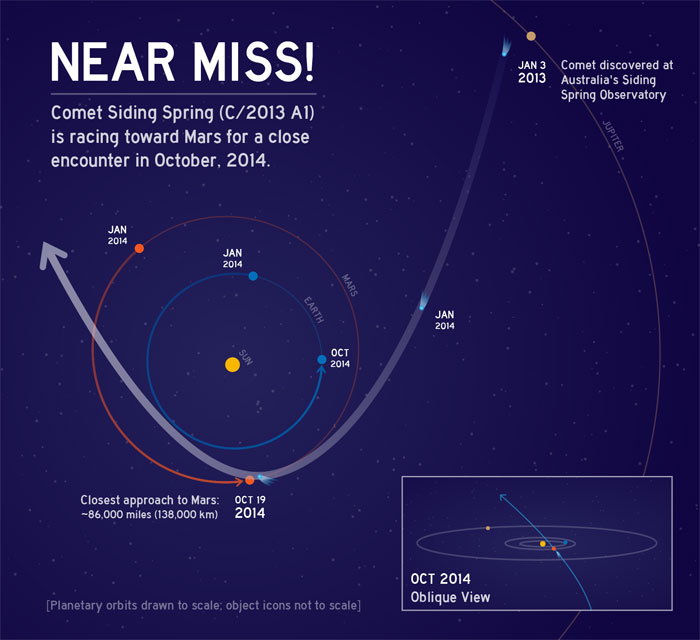
.
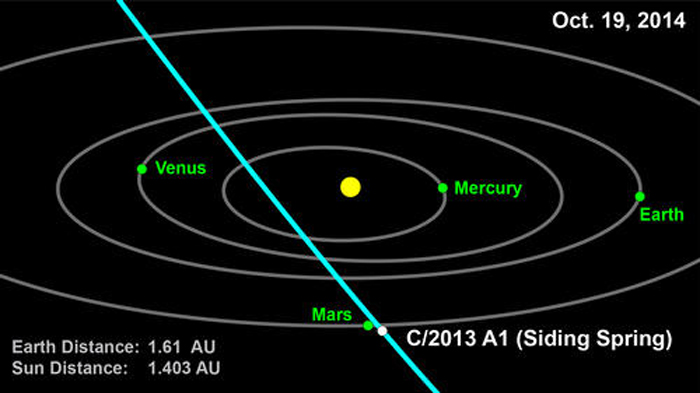
Comet 2013 A1 (Siding Spring)
This computer graphic depicts the orbit of comet 2013 A1 (Siding Spring) through the inner solar system. On Oct. 19, 2014, it is expected to pass within 186,000 miles (300,000 kilometers) of Mars. Image credit: NASA/JPL-Caltech
Image Credit: NASA/JPL-Caltech
.
Comet to Make Close Flyby of Red Planet in October 2014
Comet 2013 A1 (Siding Spring) will make a very close approach to Mars in October 2014.
The latest trajectory of comet 2013 A1 (Siding Spring) generated by the Near-Earth Object Program Office at NASA's Jet Propulsion Laboratory in Pasadena, Calif., indicates the comet will pass within 186,000 miles (300,000 kilometers) of Mars and there is a strong possibility that it might pass much closer. The NEO Program Office's current estimate based on observations through March 1, 2013, has it passing about 31,000 miles (50,000 kilometers) from the Red Planet's surface. That distance is about two-and-a-half times that of the orbit of outermost moon, Deimos.
Scientists generated the trajectory for comet Siding Spring based on the data obtained by observations since October 2012. Further refinement to its orbit is expected as more observational data is obtained. At present, Mars lies within the range of possible paths for the comet and the possibility of an impact cannot be excluded. However, since the impact probability is currently less than one in 600, future observations are expected to provide data that will completely rule out a Mars impact.
During the close Mars approach the comet will likely achieve a total visual magnitude of zero or brighter, as seen from Mars-based assets. From Earth, the comet is not expected to reach naked eye brightness, but it may become bright enough (about magnitude 8) that it could be viewed from the southern hemisphere in mid-September 2014, using binoculars, or small telescopes.
Scientists at the Near-Earth Object Program Office estimate that comet Siding Spring has been on a more than a million-year journey, arriving from our solar system's distant Oort cloud. The comet could be complete with the volatile gases that short period comets often lack due to their frequent returns to the sun's neighborhood.
Rob McNaught discovered comet 2013 A1 Siding Spring on Jan. 3, 2013, at Siding Spring Observatory in Australia. A study of germane archival observations has unearthed more images of the comet, extending the observation interval back to Oct. 4, 2012.
NASA detects, tracks and characterizes asteroids and comets passing close to Earth using both ground- and space-based telescopes. The Near-Earth Object Observations Program, commonly called "Spaceguard," discovers these objects, characterizes a subset of them, and plots their orbits to determine if any could be potentially hazardous to our planet.
.
NASA-Video hierzu: http://www.youtube.com/watch?v=1T2eBSexgX4
.
Quelle: NASA
.
Update: 7.10.2014
.
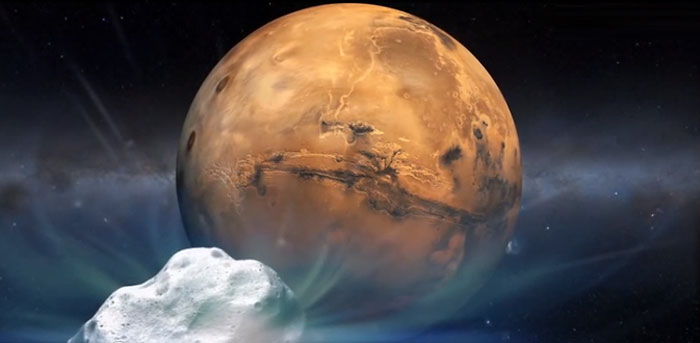
NASA Holds Media Briefing to Discuss Comet Flyby of Mars Observations
.
NASA will host a media briefing at 2 p.m. EDT Thursday, Oct. 9, to outline the space and Earth-based assets that will have extraordinary opportunities to image and study a comet from relatively close range to Mars on Sunday, Oct. 19.
The briefing will be held in NASA Headquarters’ auditorium, 300 E Street SW in Washington, and broadcast live on NASA Television and the agency’s website.
Comet C/2013 A1 Siding Spring will miss Mars by only about 88,000 miles (139,500 kilometers). That is less than half the distance between Earth and its moon and less than one-tenth the distance of any known comet flyby of Earth. The comet's nucleus will come closest to Mars at about 2:27 p.m. EDT (11:27 a.m. PDT), hurtling at about 126,000 mph (56 kilometers per second), relative to Mars.
The concerted campaign of observations by multiple spacecraft at Mars and by numerous NASA assets is directed at the comet and its effect on the Martian atmosphere. The observations of the comet may yield fresh clues to our solar system's earliest days more than four billion years ago.
Panelists include:
Jim Green, director, Planetary Science Division (PSD), NASA Headquarters, Washington
Kelly Fast, program scientist, PSD
Carey Lisse, senior astrophysicist, Johns Hopkins University Applied Physics Laboratory, Laurel, Maryland
Padma Yanamandra-Fisher, senior research scientist, Space Science Institute, Rancho Cucamonga Branch, California
Quelle: NASA
.
Update: 10.10.2014
.
NASA Prepares its Science Fleet for Oct. 19 Mars Comet Encounter
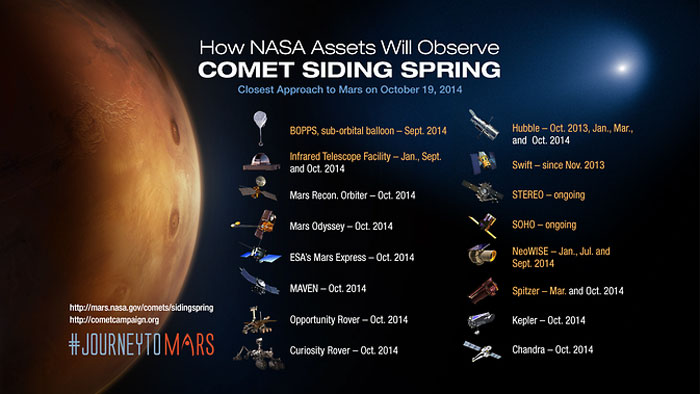
NASA’s extensive fleet of science assets, particularly those orbiting and roving Mars, have front row seats to image and study a once-in-a-lifetime comet flyby on Sunday, Oct. 19.
.
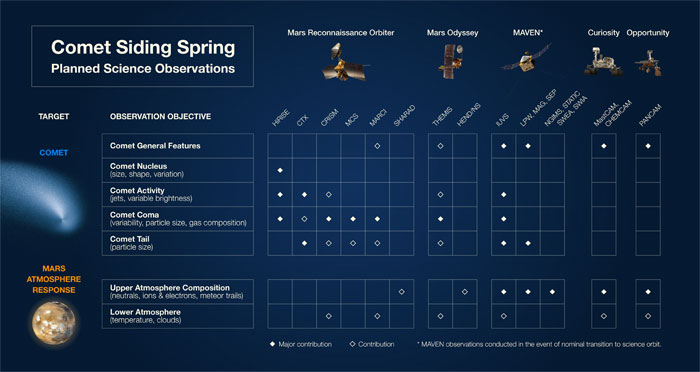
Comet C/2013 A1, also known as comet Siding Spring, will pass within about 87,000 miles (139,500 kilometers) of the Red Planet -- less than half the distance between Earth and our moon and less than one-tenth the distance of any known comet flyby of Earth.
Siding Spring’s nucleus will come closest to Mars around 2:27 p.m. EDT, hurtling at about 126,000 mph (56 kilometers per second). This proximity will provide an unprecedented opportunity for researchers to gather data on both the comet and its effect on the Martian atmosphere.
“This is a cosmic science gift that could potentially keep on giving, and the agency’s diverse science missions will be in full receive mode,” said John Grunsfeld, astronaut and associate administrator for NASA’s Science Mission Directorate in Washington. “This particular comet has never before entered the inner solar system, so it will provide a fresh source of clues to our solar system's earliest days.”
Siding Spring came from the Oort Cloud, a spherical region of space surrounding our sun and occupying space at a distance between 5,000 and 100,000 astronomical units. It is a giant swarm of icy objects believed to be material left over from the formation of the solar system.
Siding Spring will be the first comet from the Oort Cloud to be studied up close by spacecraft, giving scientists an invaluable opportunity to learn more about the materials, including water and carbon compounds, that existed during the formation of the solar system 4.6 billion years ago.
Some of the best and most revealing images and science data will come from assets orbiting and roving the surface of Mars. In preparation for the comet flyby, NASA maneuvered its Mars Odyssey orbiter, Mars Reconnaissance Orbiter (MRO), and the newest member of the Mars fleet, Mars Atmosphere and Volatile EvolutioN (MAVEN), in order to reduce the risk of impact with high-velocity dust particles coming off the comet.
The period of greatest risk to orbiting spacecraft will start about 90 minutes after the closest approach of the comet's nucleus and will last about 20 minutes, when Mars will come closest to the center of the widening trail of dust flying from the comet’s nucleus.
"The hazard is not an impact of the comet nucleus itself, but the trail of debris coming from it. Using constraints provided by Earth-based observations, the modeling results indicate that the hazard is not as great as first anticipated. Mars will be right at the edge of the debris cloud, so it might encounter some of the particles -- or it might not," said Rich Zurek, chief scientist for the Mars Exploration Program at NASA's Jet Propulsion Laboratory (JPL) in Pasadena, California.
The atmosphere of Mars, though much thinner that Earth's, will shield NASA Mars rovers Opportunity and Curiosity from comet dust, if any reaches the planet. Both rovers are scheduled to make observations of the comet.
NASA’s Mars orbiters will gather information before, during and after the flyby about the size, rotation and activity of the comet's nucleus, the variability and gas composition of the coma around the nucleus, and the size and distribution of dust particles in the comet's tail.
Observations of the Martian atmosphere are designed to check for possible meteor trails, changes in distribution of neutral and charged particles, and effects of the comet on air temperature and clouds. MAVEN will have a particularly good opportunity to study the comet, and how its tenuous atmosphere, or coma, interacts with Mars' upper atmosphere.
Earth-based and space telescopes, including NASA’s iconic Hubble Space Telescope, also will be in position to observe the unique celestial object. The agency’s astrophysics space observatories -- Kepler, Swift, Spitzer, Chandra -- and the ground-based Infrared Telescope Facility on Mauna Kea, Hawaii -- also will be tracking the event.
NASA’s asteroid hunter, the Near-Earth Object Wide-field Infrared Survey Explorer (NEOWISE), has been imaging, and will continue to image, the comet as part of its operations. And the agency’s two Heliophysics spacecraft, Solar TErrestrial RElations Observatory (STEREO) and Solar and Heliophysics Observatory (SOHO), also will image the comet. The agency’s Balloon Observation Platform for Planetary Science (BOPPS), a sub-orbital balloon-carried telescope, already has provided observations of the comet in the lead-up to the close encounter with Mars.
.
CRISM Prepares For Mars-grazing Comet Siding Spring
.
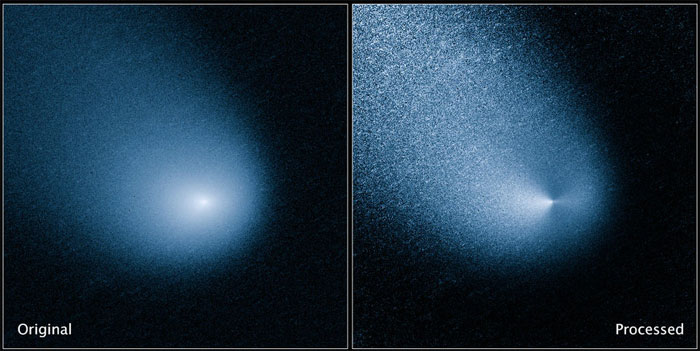
Hubble Image of Comet Siding Spring
The images above show -- before and after filtering -- comet C/2013 A1, also known as Siding Spring, as captured by Wide Field Camera 3 on NASA's Hubble Space Telescope.
On October 19, a comet that has travelled many billions of miles will come within about 87,000 miles of Mars - about one-third of the distance of the Moon from Earth. Comet Siding Spring comes from the Oort Cloud, material left over from the formation of the solar system. "This comet is coming into the solar system straight from the Oort Cloud. It's likely this is its first time this close to the sun," said space scientist David Humm, of the Johns Hopkins University Applied Physics Laboratory (APL) in Laurel, Maryland.
Oort Cloud material, including comets, is scattered through a vast region that begins outside the orbits of Neptune and Pluto and extends a substantial fraction of the distance to Proxima Centauri, the closest neighboring star. Oort Cloud comets can tell scientists about the materials - including water and carbon compounds - that existed during the formation of the solar system some 4.6 billion years ago.
Studying this close encounter will be the largest fleet of orbiting scientific observatories ever flown to another world, orbiting around (and rolling on the ground of) Mars. These instruments will, for the first time ever, have the chance to make close-up observations of a comet new to the inner solar system. And though it will not be the easiest task, the teams operating these instruments and spacecraft have developed plans to take advantage of this rare opportunity.
"The close fly-by of Mars by Comet Siding Spring is unique, unexpected, and lucky for us," said Humm, who serves as instrument scientist for the Compact Reconnaissance Imaging Spectrometer for Mars (CRISM), built by APL, and one of the instruments on board NASA's Mars Reconnaissance Orbiter (MRO) that will observe Siding Spring. Two other MRO instruments observing the comet will be the High Resolution Imaging Science Experiment (HiRISE), a very high-definition camera, and the Context Imager (CTX). Together, all three imagers will attempt to capture data about Siding Spring that is unobtainable from Earth. Though Earth-based observations of Siding Spring will reveal a great deal of information, "CRISM has a significant advantage due to its proximity to the comet at closest approach," he said.
"CRISM is both a spectrometer and a camera," Humm explained. "It can identify molecules by the light they emit and characterize minerals by the light they reflect. We can then make an image of any material we identify, and see its distribution. If we're fortunate, CRISM will be able to detect some features in the comet gas and dust, and we can make images of the distribution of different gases detected and learn something about the nature of the dust."
There are some challenges. First, though the chances of any comet dust impacting the spacecraft are thought to be very minimal, the decision was made to "hide" the spacecraft in the shadow of Mars after the comet passes, to let the planet absorb any potentially damaging high-speed dust particles that may trail the comet as it passes by.
The greater problem, explained Humm, is that "these instruments are designed for looking at the surface of Mars during daytime, not at a far dimmer comet in the night sky." But the teams have overcome that challenge as well, and now have full observation plans for Siding Spring.
Siding Spring is small (the nucleus is less than a mile in diameter) and fast (it will pass Mars at about 34 miles per second). CRISM, HiRISE, and CTX were built to study a slowly-moving planet, so they will use MRO's ability to rotate in order to capture images as the comet speeds by Mars. The instruments will observe the comet repeatedly for two and a half days as it gets closer and closer to Mars before it makes its closest approach. The peak density of comet dust at Mars is expected 98 minutes after closest approach of the nucleus, and the MRO spacecraft will position itself behind the planet at that time.
Last year's October 1 encounter with Comet ISON - a sungrazing comet that passed within 6.5 million miles of Mars - gave the teams on CRISM and the other Mars observatories a good chance to practice looking at an object hurtling past the planet.
The instruments on MRO are unique in their abilities to study the comet. "HiRISE is the only instrument that can image the nucleus of Comet Siding Spring with more than one pixel, and CRISM will have the best signal-to-noise ratio of any spectrometer that will observe the comet from close up," Humm said.
Still, comet behaviors are peculiar and may seem random; sometimes they fizzle out, sometimes they get very bright, sometimes they do both. "Comets are very unpredictable," said Humm. "No two ever seem to be the same. A new comet like Siding Spring will bring surprises."
Images from Earth-based observatories and the Hubble Space Telescope have shown a typical coma of gas and dust develop as Comet Siding Spring has come closer to the sun. The coma may be larger or smaller when the comet flies by Mars. "If the comet is really active, then we will get good spectra of the coma," Humm explained. "If the comet is inactive, then some of the compositional results could be in question but we may still see broad color differences."
For Humm and other scientists on the CRISM and other MRO teams, an event like the encounter with Siding Spring was not even considered during construction and launch of the orbiter and its instruments back in 2005.
"I would have been very surprised if you had told me we were going to use CRISM to look at a comet," Humm said. "The likelihood of being this close to a new comet is really very small, and we're operating well beyond our design lifetime, so this exciting an opportunity is completely unexpected."
.
Where is the Comet Now?
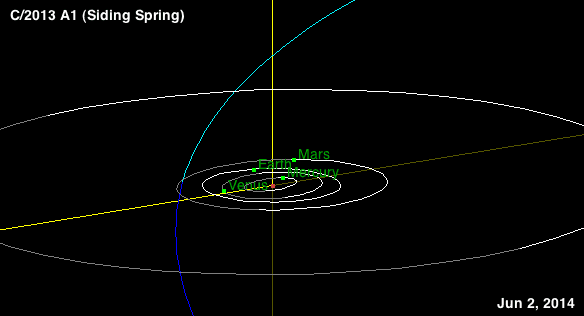
.
Update: 18.10.2014
.
MARS AND COMET SIDING SPRING
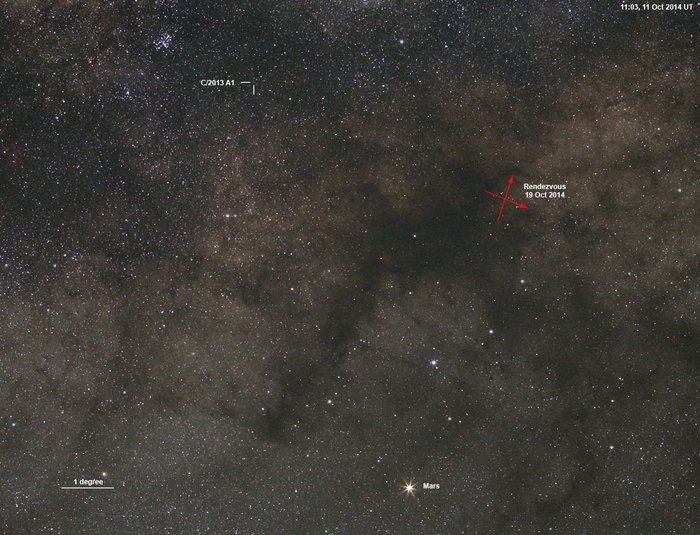
Comet C/2013 A1 Siding Spring and Mars in the same image, with the closest approach location marked with red arrows, by an amateur astronomer in Australia. Closest approach takes place 19 October 2014 at 18:27 GMT (20:27 CEST).
.
Europe’s Mars orbiter and its scientific instruments will have a frontrow seat on Sunday when Comet Siding Spring grazes the Red Planet, skimming past at a little more than a third of the Moon’s distance from Earth.
Comet Siding Spring, discovered in January 2013, is less than a kilometre across and will pass Mars at 56 km/s, closing to within 139 500 km at 18:27 GMT (20:27 CEST) on 19 October.
Initially, the comet and its envelope of gas and dust were predicted to pass much closer to Mars, posing a serious risk to the fleet of orbiting spacecraft. Later observations confirmed that the miss distance will, in fact, be more comfortable.
ESA’s teams flying Mars Express have spent months preparing for the encounter.
“In 2013, we had very little information about the comet, which was still very far and faint. In the worst case, we expected the pass to be much closer, and the comet to be much more active,” says Spacecraft Operations Manager Michel Denis.
“We designed a special mode for Mars Express that would minimise any risk due to impacts with cometary particles.
“This included turning off all instruments and non-essential onboard systems, and turning the spacecraft so as to use the large high-gain antenna as a shield.”
Opportunity for unique science
Instead, Mars Express will operate substantially normally, and the close flyby will present an invaluable opportunity for science, including close-up observations of this enigmatic comet, the Mars atmosphere under the direct influence of the comet’s gas and dust, and the complex three-way interaction between Mars, the comet and the solar wind.
The detailed observation plans include high-resolution imaging of the comet and its structure.
“Most interestingly, we may also obtain images of cometary particles – meteors – burning up in the martian atmosphere, allowing an in-depth comparison of meteor science between Earth and Mars,” notes Håkan Svedhem, project scientist for Mars Express.
Oort Cloud object comes near
Siding Spring spent most of its life in the Oort Cloud, a shell surrounding our Sun some 5000–100 000 times the Earth–Sun distance and containing billions of comets thought to be left over from the formation of our Solar System.
“The best estimate of the maximum distance of Siding Spring is 60 000 times Earth’s distance from the Sun – almost exactly a light-year,” says Håkan.
“This makes it an extraordinary comet. It has most likely never been close to the Sun before.”
Siding Spring will be the first Oort Cloud comet to be studied up close by spacecraft, giving scientists an invaluable opportunity to learn more about the materials, including water and carbon compounds, that existed during the formation of the Solar System 4.6 billion years ago.
Despite the much reduced risk of particle impacts on Mars Express, the control team will be watching closely on Sunday evening to ensure its safety.
Updates will be posted in the Mars Express blog and a webcast from ESA’s Space Operations Centre, ESOC, in Darmstadt, Germany, will be streamed live 19 October, starting at 17:50 GMT (19:50 CEST).
Quelle: ESA
.
Update: 19.10.2014
.
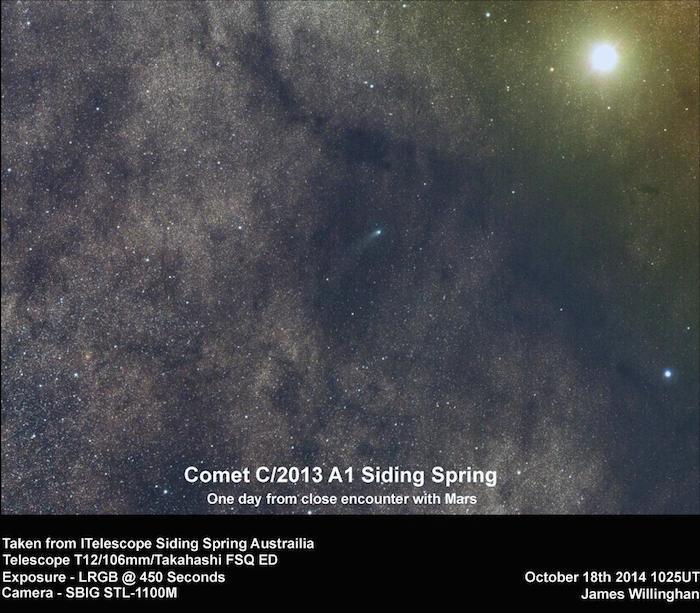
Quelle: NASA
.
Update: 22.00 MESZ
.
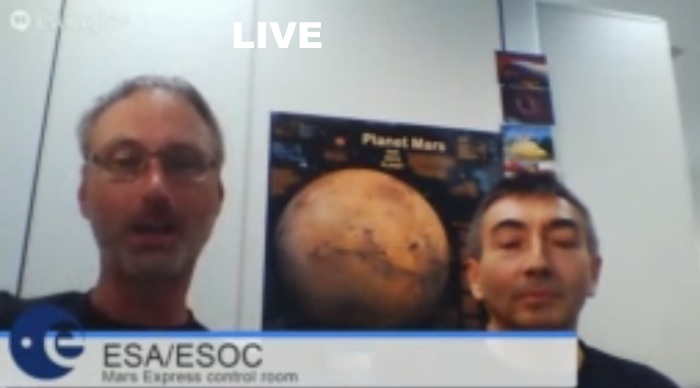
...
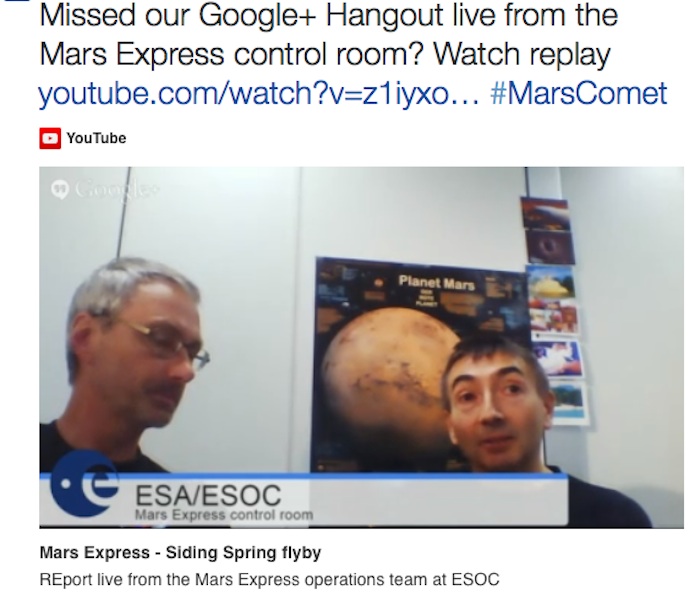
...

Quelle: ESA
...
.
Update: 20.10.2014
.
Komet raste in Rekordnähe am Mars vorbei
Der Komet Siding Spring kam dem Mars bis zu 140.000 Kilometer nahe. Ein Nichts unter kosmischen Bedingungen. Ein Großaufgebot an Sonden, Marsfahrzeugen und Teleskopen verfolgte das Ereignis.
Ein Komet ist am Sonntag in Rekordnähe an einem Planeten vorbeigerast. Der Schweifstern „Siding Spring“ passierte den Mars in nur knapp 140.000 Kilometer Entfernung. Das ist etwa ein Drittel der Distanz zwischen der Erde und dem Mond. Zur Zeit der größten Annäherung um 20.27 Uhr MESZ bewegte SICH der Komet im Verhältnis zum Roten Planeten mit einer Geschwindigkeit von 203.000 Kilometern in der Stunde, wie die Nasa vorab berechnet hatte.
Es ist das bisher erste Mal in der Geschichte der Wissenschaft, dass SICH ein Komet einem Planeten derart stark genähert hat, sagte Guy Webster vom Jet Propulsion Laboratory der US-Weltraumbehörde der Nachrichtenagentur dpa.
„Wir sind alle sehr begeistert.“ Gleich ein Großaufgebot an Raumsonden, Teleskopen und Mars-Fahrzeugen hatte das Ereignis beobachtet. Darunter war der „Mars Reconnaissance Orbiter“. Er umkreist den Roten
Planeten und schickte schon kurz nach dem Vorbeiflug erste Daten über den FLIRT zwischen Kometen und Planeten zur Erde - nach Angaben der Nasa ein Zeichen dafür, dass die Sonde den Ansturm von Staub-Partikeln des Besuchers gesund überstanden hat.
Wissenschaftler erhoffen SICH von dem Rendezvous wichtige Erkenntnisse: über die Zusammensetzung des Kometen, der ein Überrest aus der Entstehung unseres Sonnensystems ist, sowie über das Wechselspiel zwischen der Mars-Atmosphäre und ihrem Umfeld. Der Komet mit der wissenschaftlichen Bezeichnung „C/2013 A1“ stammt aus der sogenannten Oortschen Wolke. Diese riesige Region in den Tiefen des Weltalls hat SICH seit der Geburtsstunde des Planetensystems kaum verändert. Entdeckt wurde der Schweifstern von Robert H. McNaught am Siding Spring Observatorium IN AUSTRALIEN.
Quelle: Der Tagesspiegel
.
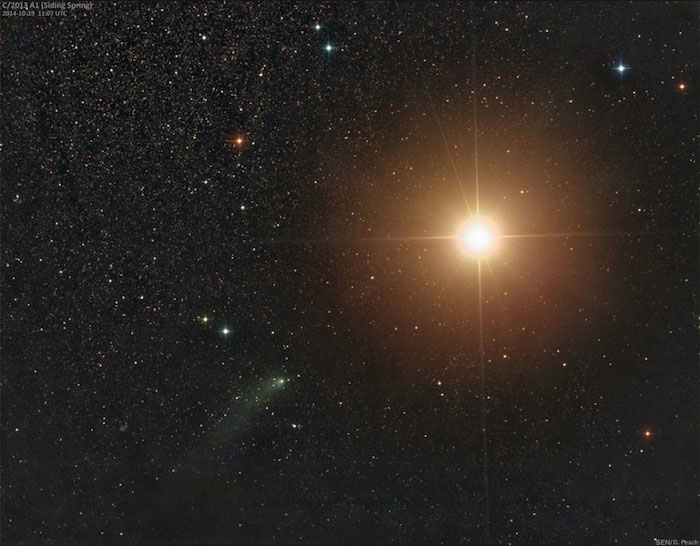
Comet Siding Spring Passes Mars
Image Credit & Copyright: SEN/Damian Peach
Explanation: Yesterday, a comet passed very close to Mars. In fact, Comet C/2013 A1 (Siding Spring) passed closer to the red planet than any comet has ever passed to Earth in recorded history. To take advantage of this unique opportunity to study the close interaction of a comet and a planet, humanity currently has five active spacecraft orbiting Mars: NASA's MAVEN, MRO, Mars Odyssey, as well as ESA's Mars Express, and India's Mars Orbiter. Most of these spacecraft have now sent back information that they have not been damaged by small pieces of the passing comet. These spacecraft, as well as the two active rovers on the Martian surface -- NASA's Opportunity and Curiosity -- have taken data and images that will be downloaded to Earth for weeks to come and likely studied for years to come. The featured image taken yesterday, however, was not taken from Mars but from Earth and shows Comet Siding Spring on the lower left as it passed Mars, on the upper right.
.
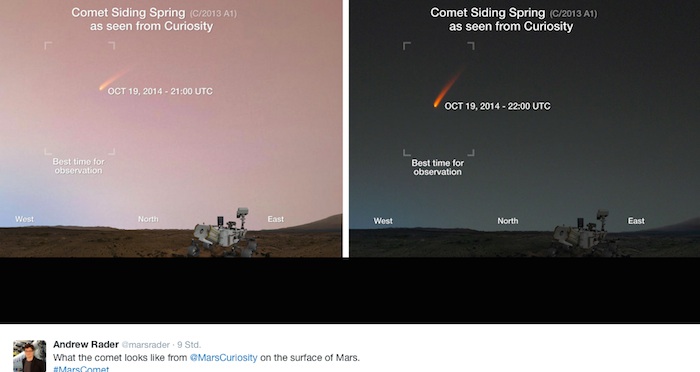
Quelle. NASA
.
Update: 21.10.2014
.
Mars Orbiter Image Shows Comet Nucleus is Small
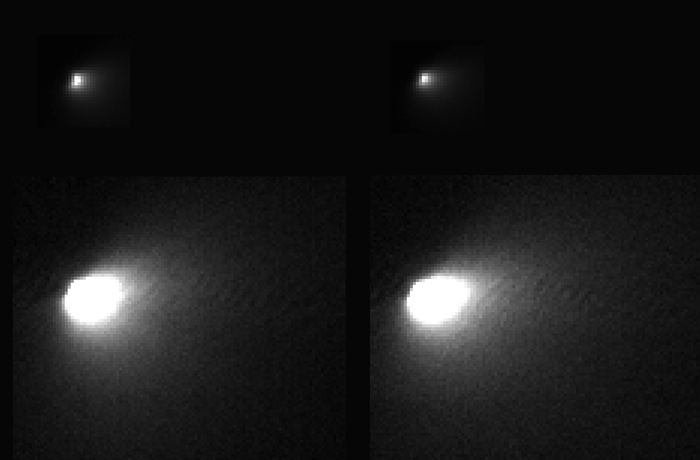
These images were taken of comet C/2013 A1 Siding Spring by NASA's Mars Reconnaissance Orbiter on Oct. 19, 2014, during the comet's close flyby of Mars and the spacecraft. Image credit: NASA/JPL-Caltech/University of Arizona
.
The High Resolution Imaging Science Experiment (HiRISE) camera on NASA's Mars Reconnaissance Orbiter captured views of comet C/2013 A1 Siding Spring while that visitor sped past Mars on Sunday (Oct. 19), yielding information about its nucleus.
The images are the highest-resolution views ever acquired of a comet coming from the Oort Cloud at the fringes of the solar system. Other spacecraft have approached and studied comets with shorter orbits. This comet's flyby of Mars provided spacecraft at the Red Planet an opportunity to investigate from close range.
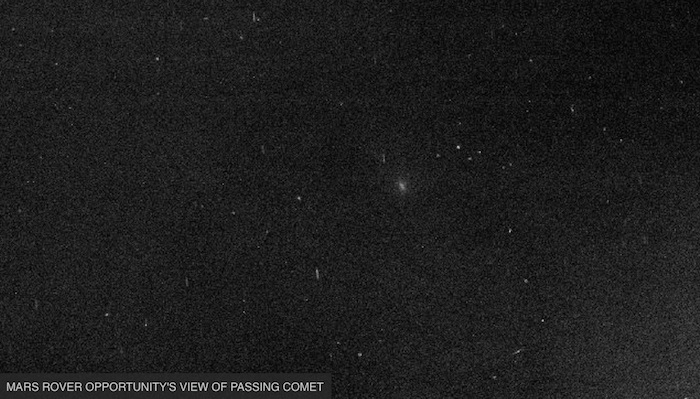
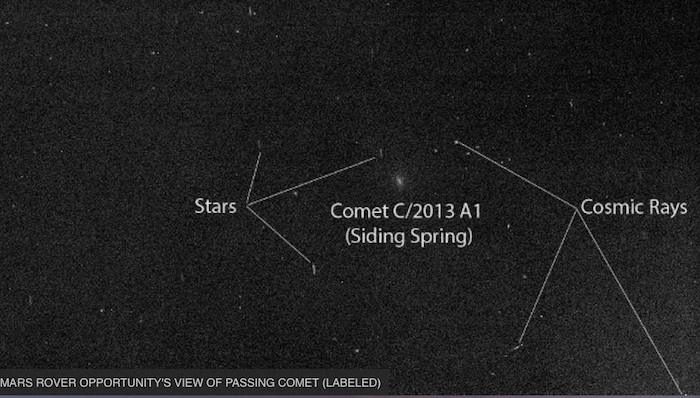
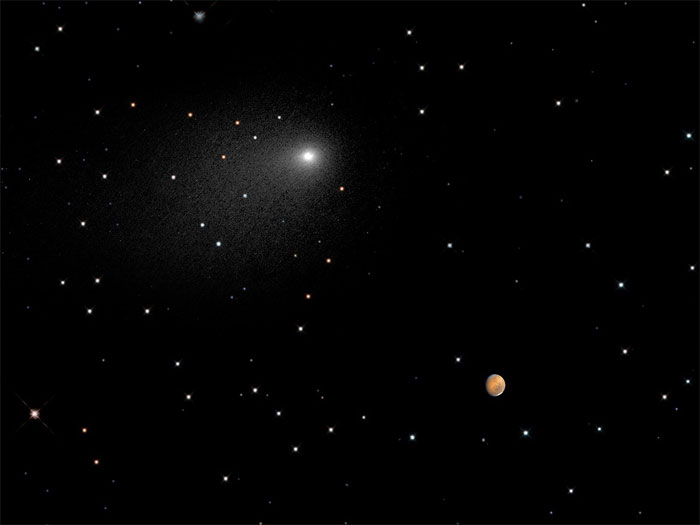

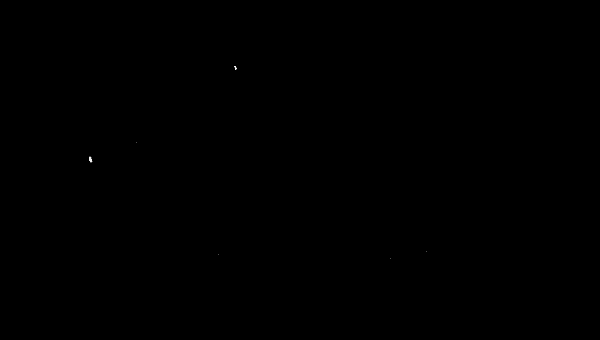
The highest-resolution of images of the comet's nucleus, taken from a distance of about 86,000 miles (138,000 kilometers), have a scale of about 150 yards (138 meters) per pixel. Telescopic observers had modeled the size of the nucleus as about half a mile, or one kilometer wide. However, the best HiRISE images show only two to three pixels across the brightest feature, probably the nucleus, suggesting a size smaller than half that estimate.
.

-

Quelle: NASA
.
Update: 23.10.2014

A NASA Hubble Space Telescope composite image shows the positions of comet Siding Spring and Mars as the comet streaked by the red planet, at 2:28 p.m. EDT on Oct. 19, 2014. Credit: NASA, ESA, PSI, JHU/APL, STScI/AURA
.
NASA’s Hubble Space Telescope has produced a unique composite image of comet Siding Spring as it made its never-before-seen close passage of a comet by Mars.
Siding Spring, officially designated Comet C/2013 A1, made its closest approach to Mars at 2:28 p.m. EDT on Oct. 19, at a distance of approximately 87,000 miles. That is about one-third of the distance between Earth and the moon. At that time, the comet and Mars were about 149 million miles from Earth.
The comet image is a composite of Hubble exposures taken between Oct. 18, 8:06 a.m. to Oct. 19, 11:17 p.m. Hubble took a separate image of Mars at 10:37 p.m. on Oct. 18.
The Mars and comet images have been added together to create a single picture to illustrate the angular separation, or distance, between the comet and Mars at closest approach. The separation is approximately 1.5 arc minutes, or one-twentieth of the angular diameter of the full moon. The background star field in this composite image is synthesized from ground-based telescope data provided by the Palomar Digital Sky Survey, which has been reprocessed to approximate Hubble’s resolution.
The solid icy comet nucleus is too small to be resolved in the Hubble picture. The comet’s bright coma, a diffuse cloud of dust enshrouding the nucleus, and a dusty tail, are clearly visible.
This is a composite image because a single exposure of the stellar background, comet Siding Spring, and Mars would be problematic. Mars actually is 10,000 times brighter than the comet, so it could not be properly exposed to show detail in the Red Planet. The comet and Mars also were moving with respect to each other and could not be imaged simultaneously in one exposure without one of the objects being motion blurred. Hubble had to be programmed to track on the comet and Mars separately in two different observations.
NASA used its extensive fleet of science assets, particularly those orbiting and roving Mars, to image and study this once-in-a-lifetime comet flyby. In preparation for the comet flyby, NASA maneuvered its Mars Odyssey orbiter, Mars Reconnaissance Orbiter (MRO), and the newest member of the Mars fleet, Mars Atmosphere and Volatile EvolutioN (MAVEN), in order to reduce the risk of impact with high-velocity dust particles coming off the comet. Other NASA space observatories also joined Hubble in observing the encounter, along with ground-based telescopes on Earth.
Siding Spring is the first comet from our solar system’s Oort Cloud to be studied up close. The Oort Cloud, well beyond the outer-most planets that surround our sun, is a spherical region of icy objects believed to be material left over from the formation of the solar system.
Quelle: NASA
.
Update: 27.10.2014
.
MAVEN Ultraviolet Image of Comet Siding Spring's Hydrogen Coma

Image courtesy Laboratory for Atmospheric and Space Physics, University of Colorado; NASA.
NASA's Mars Atmosphere and Volatile Evolution (MAVEN) spacecraft obtained this ultraviolet image of hydrogen surrounding comet Siding Spring on Friday, Oct. 17, two days before the comet's closest approach to Mars. The Imaging Ultraviolet Spectrograph (IUVS) instrument imaged the comet at a distance of 5.3 million miles (8.5 million kilometers).
The image shows sunlight that has been scattered by atomic hydrogen, and is shown as blue in this false-color representation.
Comets are surrounded by a huge cloud of atomic hydrogen because water (H2O) vaporizes from the icy nucleus, and solar ultraviolet light breaks it apart into hydrogen and oxygen. Hydrogen atoms scatter solar ultraviolet light, and it was this light that was imaged by the IUVS.
Two observations were combined to create this image, after removing the foreground signal that results from sunlight being scattered from hydrogen surrounding Mars.
The bulk of the scattered sunlight shows a cloud that was about a half degree across on the "sky" background, comparable in size to Earth's moon as seen from Earth.
Hydrogen was detected to as far as 93,000 miles (150,000 kilometers) away from the comet's nucleus.
The distance is comparable to the distance of the comet from Mars at its closest approach. Gas from the comet is likely to have hit Mars, and would have done so at a speed of 125,000 mph (56 kilometers/second. This gas may have disturbed the Mars atmosphere.
Quelle:SD
.
Update: 3.11.2014
.
Komet Siding Spring im "Visier" der HRSC-Kamera an Bord von Mars Express

Außerordentlich nah ist der Komet Siding Spring am 19. Oktober 2014 am Mars vorbeigeflogen. Der nur etwa 500 Meter große Körper passierte den Roten Planeten in einem Abstand von "nur" 137.000 Kilometern und konnte dabei gleich von mehreren Raumsonden, die sich in der Marsumlaufbahn befinden, beobachtet werden. Auch dem Kamerasystem HRSC, das vom Deutschen Zentrum für Luft- und Raumfahrt (DLR) betrieben wird, gelang mit dem SRC-Kanal eine Serie von Bildern während Orbit 13.710 der Raumsonde Mars Express.
Die Geschwindigkeit von Siding Spring relativ zum Mars betrug während des Vorbeiflugs etwa 56 Kilometer pro Sekunde. Zwischen den einzelnen Aufnahmen liegen jeweils 171 Sekunden, die räumliche Auflösung der Daten liegt bei 17 Kilometer pro Bildpunkt. Die Animation zeigt nicht nur den Kern des Kometen, sondern auch die Wolke (Koma) aus Staub und Gas, die ihn umgibt.
Siding Spring stammt ursprünglich aus der Oortschen Wolke, einem Kometenreservoir am Rande unseres Sonnensystems. Er wurde nach dem australischen Observatorium benannt, von dem aus der Komet mit der wissenschaftlichen Bezeichnung C/2013 A1 im Jahr 2013 entdeckt worden war. Wenn Kometen in Sonnennähe geraten, bilden sich auf ihrer sonnenabgewandten Seite aufgrund des Sonnenwinds ein oder zwei Schweife aus Gas und Staub bzw. aus ionisierten Gasen aus. Der Schweif von Siding Spring trat bei seinem Vorbeiflug am Mars in dessen Atmosphäre ein und wurde dabei unter anderem vom Teilchendetektor ASPERA-3 an Bord der ESA-Raumsonde Mars Express untersucht. Von den Ergebnissen dieser Untersuchung sowie von Spektrometermessungen, die ebenfalls durchgeführt wurden, versprechen sich die Wissenschaftler Aufschluss über die Zusammensetzung dieses Kometen. Man geht davon aus, dass Kometen Material aus dem Ursprung des Sonnensystems enthalten können.
Quelle: DLR
5722 Views
